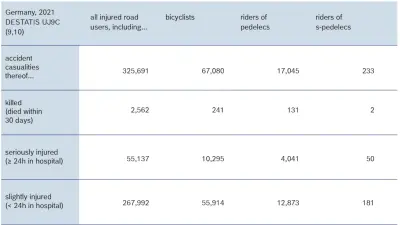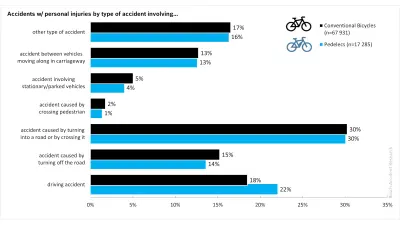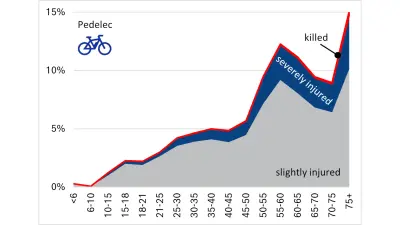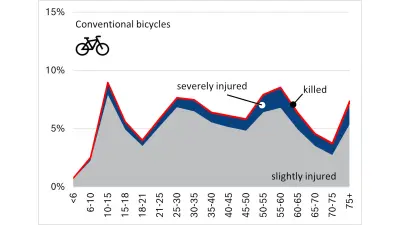Are pedelecs dangerous?
Bosch Research Blog | Post by Thomas Lich, 2023-05-30

Even before 1900, the idea of equipping a bicycle with an electric motor existed, and it took almost 100 years for this idea to establish itself on the bicycle market. Since 2005, the pedelec (pedal electric cycle) market is booming, with sales figures growing from year to year. Pedelecs are attractive especially to user groups such as commuters, mountain bikers and the elderly, as they increase the radius of activity compared to the conventional bicycle. Despite the fact that the pedelec trend is a socially desirable and ecologically sustainable mobility trend, recent articles published in the media have placed their focus on an increased number of accidents, some of them fatal – but are pedelecs really more dangerous than conventional bicycles?
The accident research team at Bosch Research is looking for answers to questions such as this one in order to identify potentially critical safety issues at an early stage. We investigate real-world traffic crashes to identify root causes of collisions and evaluate the impact of the upcoming technologies on road safety. For this purpose, a wide range of methods, from accident reconstruction using simulation methods to statistical evaluations, are applied.

What is a pedelec?
A pedelec is an electrically supported bicycle with a speed of up to 25 km/h and a motor power of up to 250 watts continuous rated power. The pedal assistance switches off automatically if the pedals are not operated or the 25km/h speed threshold is reached, but of course it allows for faster driving. From a legal standpoint, the pedelec is equal to a bicycle in most EU countries, meaning there is no need for a driving license, an insurance plate or any type of approval. Furthermore, no helmet is required as per law – but Bosch recommends wearing appropriate protective gear for all two-wheelers!
Looking at the pure statistics, the answer to the question of whether pedelecs are more dangerous than conventional bicycles seems to be answered quickly and intuitively. However, to be more objective when comparing accident figures of different types of road users, they should be put into some sort of context. Key characteristics include the overall vehicle stock, mileage travelled and the population.

More pedelecs – more kilometers – more accidents
It is obvious, the more pedelecs are on the road, the more likely it is that pedelecs are involved in accidents. Thus, we consider the overall vehicle fleet seven years after pedelecs have entered the market to achieve comparable results. In doing so, we receive an accident rate of 212 pedelec accidents per 100,000 vehicles when we consider the 17,285 pedelec crashes with personal injuries from 2021 data and eight million pedelecs in use. Compared against 22,3 million bicycles in the same timeframe, the 76,118 bicycle accidents in 2021 would result in an accident rate of 304 accidents per 100,000 vehicles. And this is much higher!

Furthermore, the risk of being involved in an accident also increases with every kilometer travelled. Pedelecs in particular are able to cover longer distances than conventional bicycles. According to Nobis, the daily distance covered on pedelecs is four to eight kilometers longer than on conventional bicycles (Federal Ministry of Transport and Digital Infrastructure, “Mobilität in Deutschland – MiD Analysen zum Radverkehr und Fußverkehr.”, pp. 59-61, Nobis, C. (2019)). On average, pedelec riders cover up to 18 km per day, whereas cyclists ride up to 12 km their bikes. If we break down the numbers to the overall kilometers travelled, it becomes clear that pedelec riding is as safe as cycling after all.

Pedelec = higher speed?
Despite of all statistics, it is a matter of fact that accidents with pedelecs often have worse consequences – is it because of the speed?
Of course, electrical support allows you to ride faster than with your conventional bicycle. After all, up to 25 km/h are possible! And this can increase the potential for accidents and injuries. However, the Pedelec-Naturalistic Cycling study conducted by the German Insurance Association (GDV) shows other figures. According to their findings, most pedelec riders do not make use the maximum speed at all, but only ride about ~2 km/h faster than conventional bicycles. We obtain similar results when we analyze our accident database from the German In-Depth Accident Study (GIDAS) project. Here, too, we found that the initial speed of pedelecs is on average ~2 km/h faster than that of conventional bikes. As the average accident speeds of pedelecs are only slightly higher than those of bicycle accidents, it can be assumed that the initially worrying statistics on pedelec accidents can be explained by the increasing sales figures and the current main customer group – older people with a higher risk of injury and less cycling experience.

Back on the bike after years
Older people in particular have widely gotten off their conventional bicycles due to physical limitations – the distances are too long or some hills to steep. But thanks to the support of pedelecs, many are back in the saddle again. In terms of activity and environment, this is good – but sometimes also dangerous. Nobis reported that pedelecs are most frequently found in households with senior citizens (over the age of 65). At the time of the study, half of the pedelec journeys were made by riders over the age of 60.
The result of this is visible in the statistics – victims of accidents with conventional bikes have a significantly lower average age compared with victims of accidents on pedelecs. Of the 67,080 injured cyclists and 17,045 injured pedelec riders, 14,779 (22%) cyclists and 7,608 (45%) pedelec users were over the age of 60 years. The significantly higher average age of pedelec riders correlates with the resulting distribution of injury severity! Typically, the older a person is, the more severe their injuries are in an accident.
-
Source: Federal Statistical Office Germany (DESTATIS), Fachserie 8 Reihe 7, 2022 -
Source: Federal Statistical Office Germany (DESTATIS), Fachserie 8 Reihe 7, 2022, UJ9C(9)
Newest technology hits inexperience
Nowadays, pedelecs are equipped with more advanced technologies, especially when it comes to the brakes. Elderly riders are suddenly experiencing a completely different brake performance, just because they change from an older conventional bicycle with a very simple cable brake to a disc brake. Their sense in reaction while riding uphill or downhill or while starting or stopping and while riding around a curve will change as well. We also see some evidence for this in police-reported accident data. All in all, what happens when someone cannot cope with the special features of their pedelec? Over-braking or a sideslip can lead to a wheel lock or to instability – and result in a fall or a collision with an object. In the terminology of accident research, these are “single-vehicle accidents”. And they are not seldom!
Single-vehicle accident or collision?
In official accident figures from 2022, we do see a somewhat higher share of driving accidents for pedelecs than for bikes – which are mainly single vehicle collisions. What’s more, single vehicle accidents often have rather minor consequences and are therefore not even reported to the police by the cyclists or pedelec rider concerned. We therefore estimate that the number of unreported cases is correspondingly high.
The GDV survey, which found that 50 percent of all bicycle accidents are single vehicle collisions, confirms this. So even the argument that motorists could underestimate the higher speed of pedelecs in traffic hardly constitutes the main risk factor for pedelecs in road traffic.

Helmet or no helmet?
In addition to other measures such as additional cycle paths or advanced vehicle assistance, self-protection must not be neglected. One of these contentious issues is the use of a helmet.
There are already many publications and studies that speak either against or for the use of a helmet. Walker describes that the helmet, in particular for cyclists (or for pedelec riders), aims to protect the head by reducing the rate at which the brain and skull is accelerated or decelerated in case of an impact (Brian Walker, “Heads up - the science of helmets”, Cycle Journal, pp. 42-45, June/July 2005).
At present, the design of the helmet prevents the worst-case scenario in terms of head and brain injury. This typically happens when the head strikes a fixed object, typically of higher stiffness, such as the road, a pole or a tree. Do you remember? These are precisely the types of single-vehicle collisions mentioned above. Despite the pros and cons of helmet use, it is and remains a protective device for the head.
Summary
All in all, an increase in the number of pedelecs and thus in the number of accidents is to be expected in Germany over the next few years due to steadily rising sales figures. But pedelecs do not have a higher accident potential than normal bikes and are therefore not more dangerous!
In summary, a pedelec is just as safe to ride as a conventional bicycle. In addition, the analysis shows us that we still need to increase our efforts in terms of infrastructure and education, be it for bicycles or pedelecs.
Furthermore, this excerpt of a more comprehensive collaboration between Bosch Research and Bosch eBike Systems enables the development of more advanced and pedelec-specific safety solutions. The Bosch eBike ABS, an anti-lock braking system introduced in 2019 and the first of its kind, offers a representative example.
Let’s make the roads safer together!
We are looking for volunteers supporting us in finding out more about bicycle/pedelec crashes.
If you would like to take part in our anonymous accident research survey and you have approximatly 5 minutes to spare, we would highly appreciate your support!
What are your thoughts on this topic?
Please feel free to share them via LinkedIn or to contact me directly.
Author: Thomas Lich
As senior expert and team leader in accident research, Thomas carries the overall responsibility for Bosch accident research worldwide. On the basis of real-world traffic accidents, he derives the strategic goals for products of the business and regional units of Bosch. In addition to his convential tasks he also represents the working group "Biomechanics and Accident Research" (AK3) from the Research Association of Automotive Technology (FAT) and is an active member of the steering committee of the German in-depth accident study (GIDAS) research initiative.





